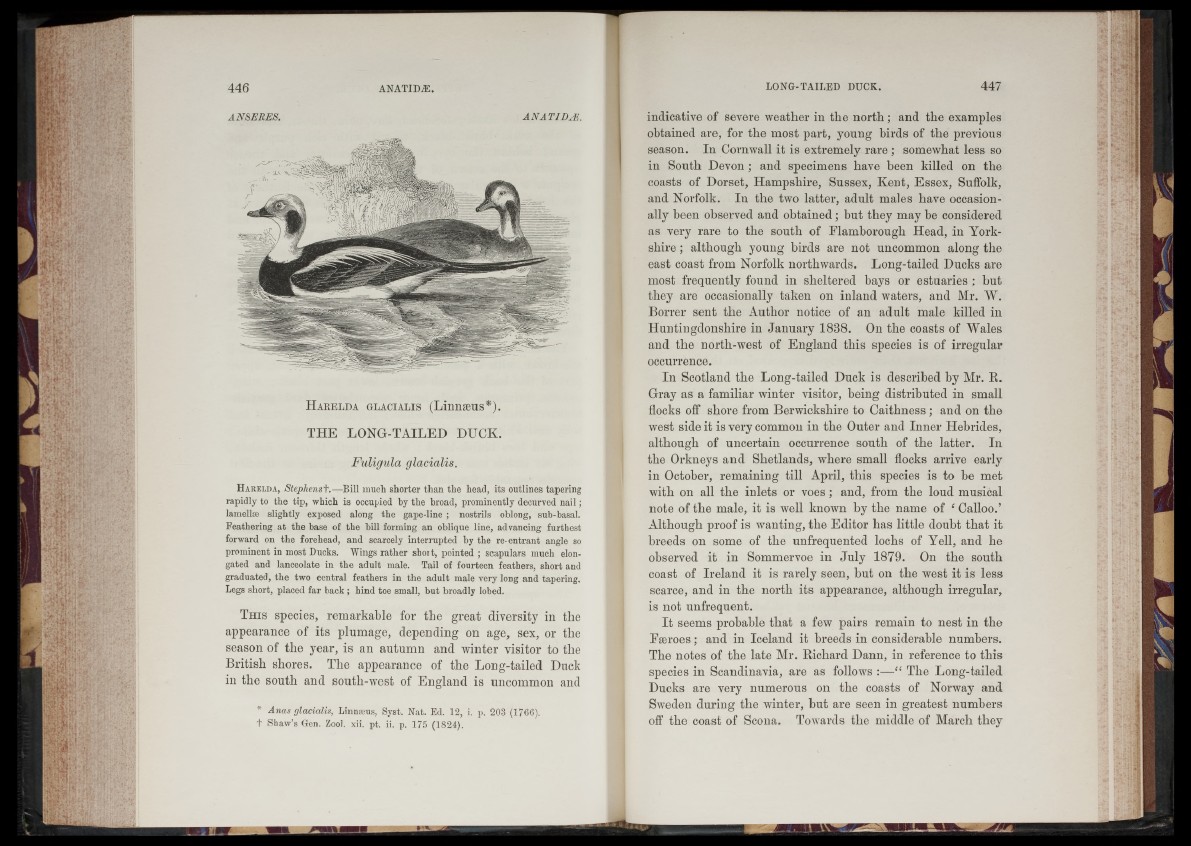
mm v 4 | ,
: ?.
KM'-i
U s f e . -
H akelda, Stephens’^.—Bill much shorter than the head, its outlines tapering
rapidly to the tip, which is occupied by the broad, prominently deeurved nail;
lamellse slightly exposed along the gape-line ; nostrils oblong, sub-basal.
Feathering at the base of the bill forming an oblique line, advancing furthest
forward on the forehead, and scarcely interrupted by the re-entrant angle so
prominent in most Ducks. Wings rather short, pointed ; scapulars much elongated
and lanceolate in the adult male. Tail of fourteen feathers, short and
graduated, the two central feathers in the adult male very long and tapering.
Legs short, placed far back ; hind toe small, but broadly lobed.
T h is species, remarkable for the great diversity in the
appearance of its plumage, depending on age, sex, or the
season of the year, is an autumn and winter visitor to the
British shores. The appearance of the Long-tailed Duck
in the south and south-west of England is uncommon and *
* Anas glacialis, Linnaeus, Syst. Nat. Ed. 12, i. p. 203 (1766).
t" Shaw’s Gen. Zool. xii. pt. ii. p. 175 (1824).
indicative of severe weather in the north; and the examples
obtained are, for the most part, young birds of the previous
season. In Cornwall it is extremely rare; somewhat less so
in South Devon ; and specimens have been killed on the
coasts of Dorset, Hampshire, Sussex, Kent, Essex, Suffolk,
and Norfolk. In the two latter, adult males have occasionally
been observed and obtained; but they may be considered
as very rare to the south of Flamborough Head, in Yorkshire
; although young birds are not uncommon along the
east coast from Norfolk northwards. Long-tailed Ducks are
most frequently found in sheltered bays or estuaries ; but
they are occasionally taken on inland waters, and Mr. W.
Borrer sent the Author notice of an adult male killed in
Huntingdonshire in January 1838. On the coasts of Wales
and the north-west of England this species is of irregular
occurrence.
In Scotland the Long-tailed Duck is described by Mr. B.
Gray as a familiar winter visitor, being distributed in small
flocks off shore from Berwickshire to Caithness; and on the
west side it is very common in the Outer and Inner Hebrides,
although of uncertain occurrence south of the latter. In
the Orkneys and Shetlands, where small flocks arrive early
in October, remaining till April, this species is to be met
with on all the inlets or voes; and, from the loud musical
note of the male, it is well known by the name of ‘ Calloo.’
Although proof is wanting, the Editor has little doubt that it
breeds on some of the unfrequented lochs of Yell, and he
observed it in Sommervoe in July 1879. On the south
coast of Ireland it is rarely seen, but on the west it is less
scarce, and in the north its appearance, although irregular,
is not unfrequent.
It seems probable that a few pairs remain to nest in the
F reroes; and in Iceland it breeds in considerable numbers.
The notes of the late Mr. Richard Dann, in reference to this
species in Scandinavia, are as follows :—“ The Long-tailed
Ducks are very numerous on the coasts of Norway and
Sweden during the winter, but are seen in greatest numbers
off the coast of Scona. Towards the middle of March they